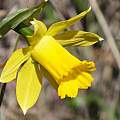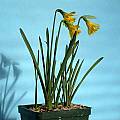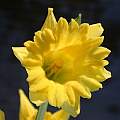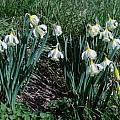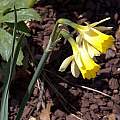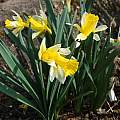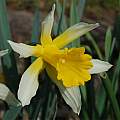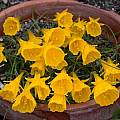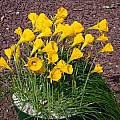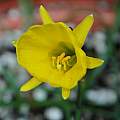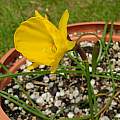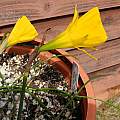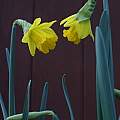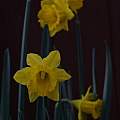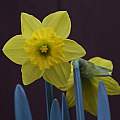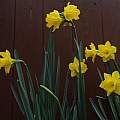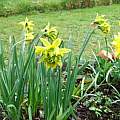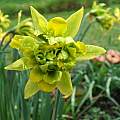Narcissus is a genus in the Amaryllidaceae family native to Europe, North Africa and Asia. As a popular garden plant it has been hybridized heavily, and there are new ones being introduced every year. Among all of the attention focused on the hybrids, species Narcissus tend to be overlooked. That's a shame, since many of the species have a delicate charm of their own.
Unfortunately, the naming of species Narcissus is a mess. Bulb expert Brian Mathew reports that they can be difficult to classify, with various authors identifying anywhere from 26 species to more than 60. Because Narcissus have been in cultivation for so long, some plants believed to be species are known only in gardens, with no known wild populations to verify them. All of this confusion is reflected in commerce, where bulbs may be sold under a variety of different names. We've done our best to classify the following photos, but this page is definitely a work in progress. Please let us know if you find an error. The species K-O will be found below.
Note: The letter and number codes after each species name refer to Brian Mathew's taxonomy of Narcissus species, which you can read here.
Narcissus lagoi. 1b(A) - classic daffodils with small flowers. North-west Spain. Up to 50 cm tall, but with small flowers.
Narcissus lobularis. An historic name, meaning 'with small lobes', see Narcissus pseudonarcissus f. lobularis. Another common synonym is Narcissus pseudonarcissus 'lobularis'.
Narcissus longispathus. 1b(B) This is a familiar looking yellow daffodil type endemic to eastern Spain and Andalusia in a few patchy populations. It is found growing in permanently wet or marshy places, even in streams, where it can grow to over ten inches and has even been reported to grow over five feet on rare occasions. Unfortunately it is considered endangered with shrinking populations due mainly to habitat loss and plant poachers. Fortunately this species is grown in cultivation, and conservation actions are taking place. Photo by Wikipedia user Juan Diego Cana, see here.
Narcissus macrolobus. 1b(B) - classic daffodils with large flowers. Pale yellow with a deeper corona. Similar to N. pallidiflorus. On the border between Spain and France.
Narcissus minor. 1b(A) - classic daffodils with small flowers. Similar to N. asturiensis, but larger. Unknown origin, may be a hybrid. Louise Beebe Wilder wrote: "It is a pretty and gay thing, its twisted perianth, flanged trumpet, rich color, and nose-dive pose giving it a dashing appearance."
Narcissus minor 'Cedric Morris' is a selection of Narcissus minor named in the 1950s. It is in bloom at Christmas time in California. Photos by John Lonsdale.
Narcissus minor var. pumilus 'Plenus' is synonymous with Narcissus 'Rip Van Winkle'. It is a diminutive double daffodil, just six inches high. It originated in Ireland at the end of the 19th. Century. Despite its name it flowers relatively early. The heavy flowers have been known to flop over after rain, best grown in a sheltered spot.
Narcissus moleroi. 1b(B) - classic daffodils with large flowers. Looks like N. alpestris, but the flowers are pale yellow and smaller. Spain.
Narcissus moschatus. 1b(B) - classic daffodils with large flowers. Tall, creamy-colored, drooping flowers. Probably from southern France or northern Spain. Has forward leaning petals that largely parallel the trumpet-shaped corona. Louise Beebe Wilder called this her favorite daffodil: "The solitary pale nodding flower has an infinite appeal, a fragile tender grace that I think is not duplicated in the race....No more exquisite flower could be found for a cool, tended corner....Not to know this daffodil is to be poor in experience." This photo by Becky Matthews was taken in rural Tennessee in March 2004.
Narcissus nanus. 1b(A) - classic daffodils with small flowers. Pale yellow petals and a deeper corona. Origin unknown.
Narcissus nevadensis. 1b(B) - (syn. N. alcaracensis, N. segurensis, N. yepesii, N. enemeritoi) classic daffodils with large flowers. Up to four flowers, yellow corona with lighter petals. Southern Spain. Photo by John Lonsdale.
Narcissus nobilis. 1b(B) - classic daffodils with large flowers. Big flowers, white petals with a dark yellow corona. Northern Spain and Portugal. Photos from Hans Joschko.
Narcissus nobilis var. leonensis has even larger flowers.
Narcissus obesus. 3 - the hoop petticoats, big conical coronas. Prostrate leaves, deep yellow flowers with incurved corona. Portugal, Morocco. Also known as N. bulbocodium ssp. obesus, this is a late-flowering species distinguished by its undulating, prostrate foliage and large golden flowers on short stems. The clone shown in the first photo taken by Jane McGary, vigorous and free-flowering, was given to Oregon gardener Molly Grothaus by British daffodil expert Frank Waley. The second photo was taken by John Lonsdale. Photos 3-5 were taken by Mary Sue Ittner of first bloom from seed. The flowers are so much larger than so many of the other species narcissus blooming at the same time.
Narcissus obvallaris. 1b(B) - classic daffodils with large flowers. Small, solid yellow flowers. Native to Spain, but naturalized in the UK. This is an adaptable plant. PBS members report that they have been able to get it to naturalize and self-sow in Oregon and Kansas City, MO. Obvallaris means "surrounded as by a wall" referring to the corona. The common name is "The Tenby Daffodil". Photos by David Pilling.
The 'Derwydd Daffodil' also known 'Thomas' Virescent Daffodil' is believed to be a double form. Photographs by Mark Brown.
Narcissus ochroleucus. 2a(i)A - colored tazetta-like flowers. Mathew says it is probably a minor variant of N. italicus, France.
Narcissus index - Overview of the Narcissus species - Narcissus Species A-B - Narcissus Species C - Narcissus Species D-J - Narcissus Species K-O - Narcissus Species P - Narcissus Species Q-Z - Narcissus hybrids - Division 1 - Division 2 - Division 3 - Division 4 - Division 5 - Division 6 - Division 7 - Division 8 - Division 9 - Division 10 - Division 11 - Division 12 - Miniatures
